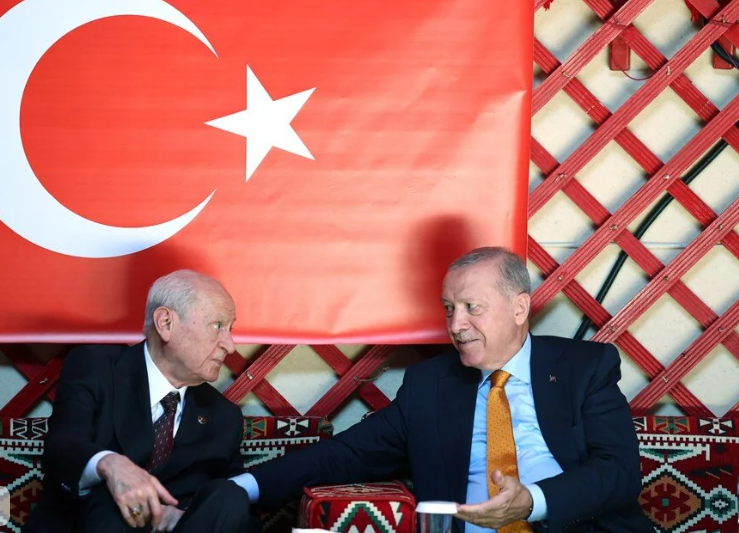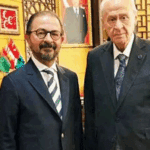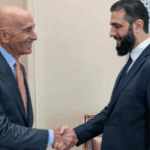President Recep Tayyip Erdoğan declared that Turkey has entered the “final stretch” of its “Terror-Free Turkey” push, using a high-profile ceremony in Ahlat to call for unity and vow that the government would not “fall for games or traps.” His appearance doubled as a carefully scrutinized encounter with Nationalist Movement Party (MHP) leader Devlet Bahçeli, coming amid speculation of strains inside the ruling alliance following the recent arrest of Selahattin Yılmaz, whom prosecutors accuse of leading an organized crime network and whom Bahçeli has publicly defended.
Speaking at the Archers Foundation’s commemoration of the 954th anniversary of the Battle of Manzikert (1071) at the Ahlat Recreation Area, Erdoğan cast Ahlat as “the emblem of our eternal and everlasting presence on these lands” and “the key to Kızılelma,” framing national cohesion as the engine of past victories and future stability. “We will tighten our ranks, reinforce our brotherhood and renew our covenant,” he said. “With a little more patience, effort and vigilance, God willing, we will pass this final stretch and reach our intended destination.” He linked the present political project to an historical arc running from Manzikert through the War of Independence to the July 15 coup attempt, asserting that Turks, Kurds and Arabs have prevailed whenever they “stood shoulder to shoulder.”
The ceremony unfolded with layered symbolism. Proceedings opened with a Qur’an recitation. Gendarmerie personnel mounted an honor watch in Seljuk Alp attire as part of a “1071 tribute,” and the field was ringed with Turkish, Seljuk and Palestinian flags. The Gendarmerie Mehteran performed as attendees joined marches waving Turkish flags. Erdoğan repeatedly praised Ahlat’s heritage, describing the town’s monuments—particularly the Seljuk cemetery and kümbets—as “the strongest witnesses of our thousand-year presence” and “embodiments of our national and spiritual virtues.”
After the speech, Erdoğan and Bahçeli were seen conversing on the sidelines before paying a joint visit to the Seljuk Meydan Cemetery, one of the world’s largest Turkic-Islamic necropolises on UNESCO’s Tentative List. The choreography continued with a closed-door, roughly 45-minute meeting at the Devlet Bey Mansion in the Emir Bayındır complex—an edifice inspired by Seljuk motifs, built of local Ahlat stone using traditional rough-hewn techniques and designed by architect Hayri Bulut, a member of the MHP’s Central Executive Board. The residence features wolf figures and the Seljuk double-headed eagle at its entrance, crescent-shaped guest rooms to the north and, on the south side, a two-story structure modeled on the Emir Bayındır Tomb (1481). A scale model of the mansion is displayed at MHP headquarters.
The Erdoğan-Bahçeli exchange carried added weight given the political backdrop. In recent days, Istanbul-led operations resulted in the detention of 17 people and the jailing of 10, including Selahattin Yılmaz. After CHP leader Özgür Özel referred to Yılmaz as a “hired killer and assassin” in a speech in Aydın, Bahçeli publicly rebuked the language and called Yılmaz his “ülküdaş” and “comrade in our cause,” accusing the opposition of degrading political discourse. Against that backdrop, Monday’s imagery from Ahlat—side-by-side appearances, heritage-themed ceremony and a private sit-down—was widely read as an effort to project cohesion. Neither camp issued a detailed readout addressing rift speculation, and both leaders kept their public remarks focused on historical themes and the “Terror-Free Turkey” agenda.
Erdoğan’s address emphasized continuity and resolve. He pledged to honor the legacy of martyrs and veterans, promising “a bright Turkey at the center of peace, tranquility and affection,” and insisted that the government would proceed “with confident, determined steps,” mindful of “what we are doing and what we intend.” He reiterated that Turkey would “not fall for anyone’s games or into traps,” and portrayed the current moment as the culmination of a long campaign: “We have reached the last stretch. With a little more patience, more effort and attention, God willing, we will arrive smoothly at our intended destination.”
The Ahlat program drew a broad slate of senior officials, including Vice President Cevdet Yılmaz, BBP leader Mustafa Destici, HÜDA PAR leader Zekeriya Yapıcıoğlu, DSP leader Önder Aksakal, cabinet ministers, party executives and provincial governors. Organizers leaned into Seljuk-era imagery and stonework to underline civilizational continuity—an aesthetic echoed in Erdoğan’s remarks, which held up Ahlat as a bridge of “faith, culture and civilization” connecting “a thousand years ago to today.”
Away from the ceremony, Erdoğan received high-schoolers participating in the Ministry of National Education’s “Maziden Atiye” program at the Ahlat Presidential Complex. The initiative, which has hosted 2,320 students to date, combines historical and cultural visits with seminars, arts events, poetry readings, book discussions, logic games, sports and workshops under themes such as “From Turkestan to Anatolia: The Spirit of Conquest.”
An additional political-cultural note surfaced in Erdoğan’s remarks: he welcomed the establishment—under Bahçeli’s direction—of the “Conquest and Root: Ahlat/Manzikert Studies Institute” within the MHP’s headquarters, calling the move auspicious. The acknowledgment signaled that, despite the swirl of commentary around arrests and rhetoric, both leaders were content to spotlight shared heritage projects and a common narrative for the day.



